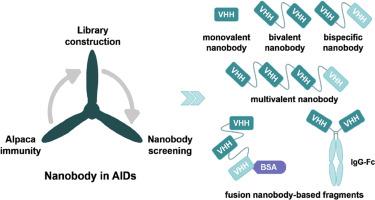Nanobody-as versatile tool emerging in autoimmune diseases
Q1 Engineering
引用次数: 0
Abstract
Nanobody (Nb) is derived from the variable domain of heavy-chain antibody (HCAb), naturally displaying notable properties like nano-scale size, exceptional stability, high specificity, low immunogenicity, and cryptic epitope accessibility. These features contribute to its great therapeutic potential as a valuable research tool across diverse diseases, especially autoimmune diseases (AIDs). Caplacizumab (Cablivi®) is the first nanobody drug approved for treating acquired thrombotic thrombocytopenic purpura (aTTP). This review summarizes the biomolecular structure, usage of Nb as a foundation of recombinant constructs, and biochemical properties of nanobodies. As attractive therapeutic candidates, many clinical trials of Nbs have been conducted, elucidating potential therapeutic strategies for AIDs. Therefore, the preclinical development and application of Nbs in AIDs are emphasized throughout this review.

纳米体--自身免疫性疾病中出现的多功能工具
纳米抗体(Nb)源自重链抗体(HCAb)的可变结构域,天然具有纳米级尺寸、超强稳定性、高特异性、低免疫原性和表位隐蔽性等显著特性。这些特性使其具有巨大的治疗潜力,成为各种疾病,尤其是自身免疫性疾病(AIDs)的重要研究工具。卡普拉珠单抗(Cablivi®)是首个获准用于治疗获得性血栓性血小板减少性紫癜(aTTP)的纳米抗体药物。本综述概述了纳米抗体的生物分子结构、作为重组构建物基础的 Nb 的使用以及纳米抗体的生化特性。作为极具吸引力的候选治疗药物,Nbs 已经开展了许多临床试验,阐明了治疗艾滋病的潜在策略。因此,本综述强调了 Nbs 在艾滋病中的临床前开发和应用。
本文章由计算机程序翻译,如有差异,请以英文原文为准。
求助全文
约1分钟内获得全文
求助全文
来源期刊

Smart Materials in Medicine
Engineering-Biomedical Engineering
CiteScore
14.00
自引率
0.00%
发文量
41
审稿时长
48 days
 求助内容:
求助内容: 应助结果提醒方式:
应助结果提醒方式:


